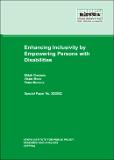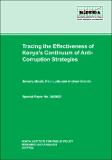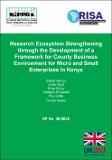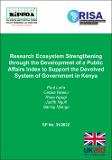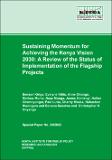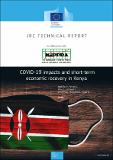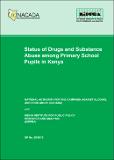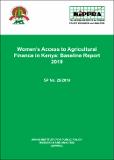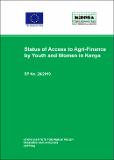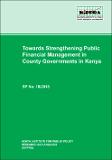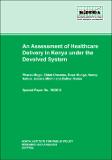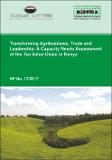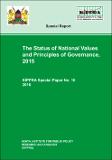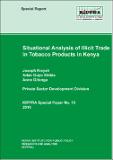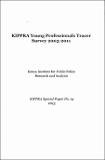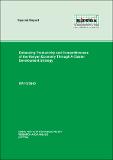Special Papers: Recent submissions
Now showing items 1-20 of 27
-
Special Paper No. 32 of 2022 on Enhancing Inclusivity by Empowering Persons with Disabilities (PWDs)
(Kenya Institute for Public Policy Research and Analysis (KIPPRA), 2022)Kenya has made milestones in legal and policy environment which aim at supporting the persons with disabilities (PWDs). This is demonstrated through the inclusion of disability issues in the Kenya Constitution (2010) and ... -
Special Paper No. 34 of 2022 on Tracing the Effectiveness of Kenya’s Continuum of Anti-Corruption Strategies Kenya
(The Kenya Institute for Public Policy Research and Analysis (KIPPRA), 2022)Corruption persistently and relentlessly remains a challenge in Kenya with a huge cost to the economy. It is a hindrance to good governance and inflicts substantial economic costs such as misappropriation or loss of ... -
Special Paper No. 30 of 2022 on Research Ecosystem Strengthening through the Development of a Framework for County Business Environment for Micro and Small Enterprises in Kenya
(The Kenya Institute for Public Policy Research and Analysis (KIPPRA), 2022)This research paper presents the County Business Environment for MSEs (CBEM) 2022. CBEM is a framework that provides a tool for monitoring progress in improving the business environment for growth and survival of MSEs. ... -
Special Paper No 31 of 2022 on Research Ecosystem Strengthening through the Development of a Public Affairs Index to Support the Devolved System of Government in Kenya
(The Kenya Institute for Public Policy Research and Analysis (KIPPRA), 2022)The Public Affairs Index (PAI) is a framework for monitoring delivery of public services at the county level. The Index helps to identify gaps, bring out emerging issues, and guide in prioritizing policy actions. The ... -
Special Paper No. 33 of 2022 on Sustaining Momentum for Achieving the Kenya Vision 2030: A Review of the Status of Implementation of the Flagship Projects
(The Kenya Institute for Public Policy Research and Analysis (KIPPRA), 2022)Kenya attained relatively higher growth rates during the Medium-Term Plan (MTP) II than during the Economic Recovery Strategy for Wealth and Employment Creation (ERS-WEC) and MTP I phases. Economic growth averaged 5.5 ... -
COVID-19 Impacts and Short-Term Economic Recovery In Kenya
(Kenya Institute for Public Policy Research and Analysis (KIPPRA), 2020)This technical report focuses on the short-term implications on the wider Kenyan economy of the COVID-19 lockdown by taking into account several impact channels (labour productivity, export demand and tourism, remittances, ... -
Special Paper No. 20 of 2019 on Status of Drugs and Substance Abuse among Primary School Pupils in Kenya
(The Kenya Institute for Public Policy Research and Analysis (KIPPRA), 2019)Introduction Studies in Kenya indicate that drugs and substance abuse among young people in learning institutions is a growing social and public health problem. Most of these studies have, however, focused on young persons ... -
Special Paper No. 29 of 2019 on Women's Access to Agricultural Finance in Kenya: Baseline Report 2019
(The Kenya Institute for Public Policy Research and Analysis (KIPPRA), 2019)The Agricultural Finance Corporation (AFC) aims to enhance access to agricultural finance by women across the agricultural value chains by increasing agricultural loans advanced to women to approximately Ksh 1.4 million ... -
Special Paper No. 28 of 2019 on Status of Access to Agri-Finance by Youth and Women in Kenya
(The Kenya Institute for Public Policy Research and Analysis (KIPPRA), 2019)Agriculture is the backbone of Kenya’s economy, directly contributing 34.2 per cent of the annual GDP and another 27 per cent indirectly (KNBS, 2019). The agricultural sector is yet to fully exploit the potential of the ... -
Special Paper No. 27 of 2019 on County Business Environment for Micro and Small Enterprises in Kenya
(The Kenya Institute for Public Policy Research and Analysis (KIPPRA), 2019)Improving the business environment for MSEs is a catalyst to leveraging fully on the potential of MSEs in contributing to the development agenda of the country. The MSMEs Survey of 2016 estimates that the MSEs sector in ... -
Special Paper No. 18 of 2018 on Towards Strengthening Public Financial Management in County Governments in Kenya
(The Kenya Institute for Public Policy Research and Analysis (KIPPRA), 2018)This report contains the findings of the sub-national Public Expenditure and Financial Accountability (PEFA) assessment carried out in six (6) counties in Kenya by the Kenya Institute for Public Policy Research and Analysis ... -
Special Paper No. 19 of 2018 on an Assessment of Healthcare Delivery in Kenya under the Devolved System
(The Kenya Institute for Public Policy Research and Analysis (KIPPRA), 2018)Access to and provision of quality health care is a basic right guaranteed by the 2010 Constitution of Kenya. In the Kenya Vision 2030, the government targets to have the entire population having access to quality and ... -
Special Paper No. 17 2017 on Transforming Agribusiness, Trade and Leadership: A Capacity Needs Assessment of the Tea Value Chain in Kenya
(The Kenya Institute for Public Policy Research and Analysis (KIPPRA), 2017)This report analyses the institutional and human capacities of the tea value chain in Kenya. This is necessitated by the need to initiate transformative actions necessary for enhancing the sub-sector’s productivity and ... -
Special Paper No. 16 of 2016 on the Status of National Values and Principles of Governance, 2015 KIPPRA
(The Kenya Institute for Public Policy Research and Analysis (KIPPRA), 2016)The Constitution of Kenya (2010) recognizes that the realization of National Values and Principles of Governance (NV&PG) articulated in Article 10 is essential for national development. Once grounded in all facets of Kenya’s ... -
Special Paper No. 15 of 2014 on Situational Analysis of Illicit Trade in Tobacco Products in Kenya
(The Kenya Institute for Public Policy Research and Analysis (KIPPRA), 2014)Illicit trade in tobacco products imposes many social and economic costs, including increased health expenditure as a result of increased access to tobacco products, and loss of government revenue through tax evasion. ... -
Report on Inequalities and Social Cohesion in Kenya: Evidence and Policy Implications
(Kenya Institute for Public Policy Research and Analysis (KIPPRA), 2013)Socio-economic development of a country involves successful interventions that improve, just the incomes of the population, but also the various widely accepted dimensions of human welfare, such as child and maternal ... -
Special Paper No. 14 of 2013 on KIPPRA Young Professionals Tracer Survey 2003-2011
(The Kenya Institute for Public Policy Research and Analysis (KIPPRA), 2013)The YP programme runs a comprehensive, practical and relevant quality curricula in policy research and analysis. It covers coursework and on-the-job training, during which interns are required to attend KIPPRA internal ... -
Report on Youth Unemployment, Under-Employment and Decent Work in Kenya
(Kenya Institute for Public Policy Research and Analysis (KlPPRA), 2012)This study presents the profile of youth unemployment and underemployment for Kenya, with findings on job quality, the size and dimensions of open unemployment and underemployment, and the role of education in reducing ... -
Special Paper No. 13 of 2012 on Enhancing Productivity and Competitiveness of the Kenyan Economy Through a Cluster Development Strategy
(The Kenya Institute for Public Policy Research and Analysis (KIPPRA), 2012)The world economy is undergoing rapid change associated with globalization and liberalization, which has increased the need for industrial competitiveness. Kenya ranks low in global competitiveness and compares ... -
Special Paper No. 07 of 2006 on Private Sector Investment in Education and Training: A Case of Tertiary Education in Kenya
(The Kenya Institute for Public Policy Research and Analysis (KIPPRA), 2006)This paper assesses the current status of private sector participation in education investment and makes policy recommendations. A cross-sectional research design was used in this study. An in-depth descriptive analysis ...

